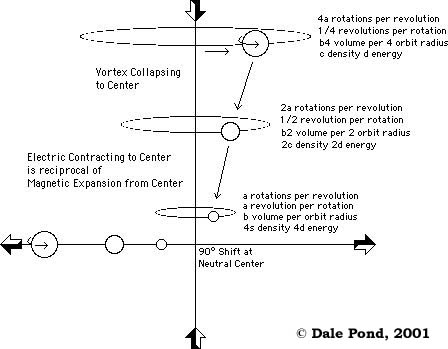Russell
"The following fundamental laws governing mathematical relations will briefly convey the idea of the Principles governing universal ratios which is in every effect of motion the direct and inverse square of the distance, area or time dimensions and the cube of volume or potential dimensions. The direct and the inverse are the two way indicators of direction, the latter belonging to gravitational and the former to radiational effects." [Russell, Genero-Radiative Concept, part 6b]
Notice the reference to the Square Law and Inverse Square Law in the above Russell quote. These two laws are reciprocals [see Covariance] of each other and reflect the natural ways force and energy interchange in nature when forming gyroscopic motions or vortices.
"All dimensions simultaneously expand and contract in opposite directions of the same ratio. [Russell, The Universal One, Book 02 - Chapter 14 - Universal Mathematics - Universal Ratios]
Figure 3.20 - The Observable Disappears into the Non-observable.
(courtesy University of Science and Philosophy)
(click to enlarge)
See Also
Figure 3.19 - The Observable forms from the Non-observable
appearance and disappearance of a harmonical cycle
cycle of appearance and disappearance of mass
disappearance
disappearance of mass
disappearance of the electron
Figure 3.20 - The Observable Disappears into the Non-observable
neutralization
voiding
Newtonian
Quantum
Scalar
Table of Cause and Effect Dualities
"Expansion pressure is in direct ratio to the square of the distance, area, plane, orbit or time unit, and to the cube of the volume.
"Contraction pressure is in inverse ratio to the square of the distance, area, plane, orbit or time unit, and to the cube of the volume." Russell, The Universal One, pg 162
"Every mass in the universe occupies a measurable potential position." Russell, The Universal One, pg 162)
Russell is referring to the Law of Relativity of Force which is indicated by E=mc2 which would be relativity of force when coupled with say Planck's Constant as a universal unit of progression in force/energy. These units of constant force and energy may be added, subtracted, multiplied and divided.
"Every generative effect of motion begins its cycle at its maximum in the region of lowest pressure, loses one half of every dimension of it at the high pressure point of its cycle wave, and exhausts its effect at the place of its beginning.
"Every radiative effect of motion begins its cycle at its minimum in the region of the lowest pressure, gains one-half of every dimension of it at the high pressure point of its cycle wave, and attains its maximum at the place of its ending." [Russell, Genero-Radiative Concept, part 6b]

See Also
13.23 - Degree of Concord Discord Determines
Affinity
Aliquot
angles of 90 degrees
Bjerknes Effect
Chord
Concord
Concordance
degree of development
degree of gravity
Degree of Harmonicity
degree of levity
degree
Figure 18.06 - Hubbard Tone Scale of Degrees or Levels of Consciousness
Figure 3.29 - Discrete Degrees or Steps of Force and Energy
Figure 3.30 - Discrete Degrees or Steps in Gyroscopic Compression Motion
Figure 5.7 - Vortices on Three Planes 90 Degrees to Each Other
Figure 8.7 - Varying Degrees of Chordal Harmony and Discord
gravitation
gravity
Harmonicity
Harmony
Law of Attraction
Law of Repulsion
Laws of Being
Laws of Music
Light Rings formed at 90 Degrees to Magnetic Center Line
ninety degrees
Part 12 - Russells Locked Potentials
plane of 90 degrees
specific gravity
subdominant chord
subdominant
Sympathetic Oscillation
Sympathetic Vibration
Sympathy
Tuning
Unison

state of turmoil
cycloid
cycloid motion
cycloid-space-curve
cycloid-space-curve-motion
cycloid-spiral-space-curve
earth
Earth Wobble
Figure 10.05 - Three Orthogonal Planes where Six Gyroscopic Vortices Converge
Figure 3.21 - Vortex or Gyroscopic Motions as Conflicts or Antagonisms between Light and Dark
Figure 3.22 - Vortex or Gyroscopic Motions as Conflicts or Antagonisms between Light and Dark Zones
Figure 3.23 - Vortex or Gyroscopic Motions as Conflicts or Antagonisms between Light and Dark Zones
Figure 3.28 - Compression and Expansion Forces in Gyroscopic Motions
Figure 3.30 - Discrete Degrees or Steps in Gyroscopic Compression Motion
Figure 4.5 - Compound Gyroscopic or Vortex Motions
Figure 5.3 - Vortex or Gyroscopic Motion is Natural and occurs ubiquitously
Figure 5.4 - Vortex and Gyroscopic Motion on One Plane then on three forming Sphere
gyroscope
gyroscopic principle
Gyroscopic Reactionless Drive
Levitating Gyroscopes
New Concept - Wobbling Gyroscopes Seek Balance
New Concept - XXXI - Introducing the Gyroscope into the Octave Wave
New Concept - XXXII - The Nucleus is the Hub of the Gyroscope Wheel
New Concept - XXXVI - Wobbling Gyroscopes Seek Balance
orbit
planet
Polarity Controlled Electric Gyroscope
spin
system of cycloid-space-curves
The Practical Application of Cycloid-Space-Curve-Motion arising from Processes of Cold Oxidation
Vortex
whirl
See Also
Covariance
3.12 - Reciprocating Duality
6.8 - Proportionate and Relative Geometries
9.12 - Velocity of Sound and its Propagation Rate are Proportional
12.00 - Reciprocating Proportionality
13.15 - Principle of Proportion
Conjugate Variables
Fibonacci Relationships
Figure 6.17 - Areas and Volumes - Relations and Proportions
Figure 6.19 - Sphere to Cube - Relations and Proportions
Figure 14.10 - Proportionate Tonal Relations dictate Contraction or Expansion
Fundamental
Interval
Keynote
Law of Assimilation
Multiplicative inverse
Part 12 - Russells Locked Potentials
Portion
Proportion
Reciprocal
Reciprocating Proportionality
Rhythmic Balanced Interchange
Square Law
substance
Table 2 - Controlling Modes and Proportions
Universal Ratios
